- Arms
- Arms 3.5 - 5 times ML.
- All arms with 29 prominent proximal suckers, diameter small.
- Suckers 5-7 cyclindrical with thick, stout stalk, separated by 1 cm,
- Following suckers, separated by 2-3 cm, with long stalks, and and with "small circular opening surrounded by very narrow rim in the upper part, with narrow infundibulum; acetabulum [a] broad chamber surrounded by highly deformable fleshy membrane in such a way that the acetabulum is able to inflate and deflate, forming spherical, flattened or half-closed eyelid."
- Proximal suckers commonly appear folded.
- Distal suckers (suckers number 30 +) abruptly different appearance: muscular with spherical base embedded in arm, bowl or barrel-shaped distal portion; suckers sessile.
- Distal suckers gradually increase in size to SDI 4.6 then decrease to arm tip.
- First minute cirri between suckers 4 and 5.
- Maximum cirri length (CiLI 71-95) 10-14 times sucker diameter.
- Mantle cavity
- Gills sepioid with 5-6 primary lamellae in outer demibranch.
- Digestive system
- Forms a simple loop.
- Digestive gland heart-shaped and olive-green color.
- Radula absent.
- Caecum larger than stomach, not forming spiral.
- Male reproductive system
- Accessory glands large; three glands covered by dark purple sac.
- Penis small, cyclindrical.
- Female reproductive system
- Distal portion of oviducal gland much larger than proximal portion.
- Distal and proximal oviducts short.
- Largest oocytes in ovary 10x8 mm.
- Shell
- Butterfly-shaped.
- Beaks
- Beaks large, thick and robust.
- Pigmentation
- Arms translucent.
- Body and arms vary from pale white to purple.
- Oral surfaces of arms and web darkest, purple or purple-brown.
- Suckers lack pigmentation.
- Cirri chesnut-brown.
- Esophagus dark purple-black; stomach brown; caecum gray; intestine dark purple.
- Measurements and counts.
| Sex measurements in mm | Female Holotype | Male | Female |
| Mantle length | 175 | 220 | 140 |
| Total length | 1155 | 1075 | 870 |
| Head width | 100 | 105 | 89 |
| Mantle width | 125 | 170 | 80 |
| Fin length | 200 | 156 | 130 |
| Fin width | 76 | 74 | 65 |
| Fin span | 513 | 483 | 321 |
| Eye diameter | - | 85 | 60 |
| Lens diameter | 29 | 28 | 25 |
| Mantle opening | 22 | 22 | 20 |
| Arm I, length | 875/875 | 748/790 | 690/- |
| Arm II, length | 870/875 | 710/700 | -/- |
| Arm III, length | 870/890 | 685/690 | -/- |
| Arm IV, length | 838/915 | 745/565 | -/- |
| Cirrus length, max. | 80 | 72 | 85 |
| Sucker diameter, max. | 8 | 9 | 6 |
| Gill length | 37 | 25 | 24 |
| Gill width | 30 | 27 | 20 |
| Gill lamellae/demibranch | 5/5 | 6/6 | 5/6 |
| Penis length | 6 | ||
| Shell width | 85 | 66.5 | 61.5 |
| Shell saddle length | 22 | 20 | 18.7 |
Measurements are taken from Guerra, et al., 1998.
Comments
The above description is taken from Guerra, et al., 1998.

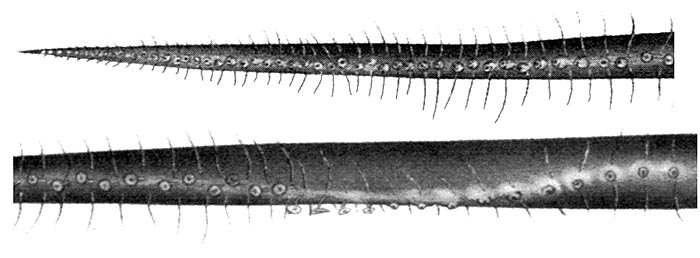
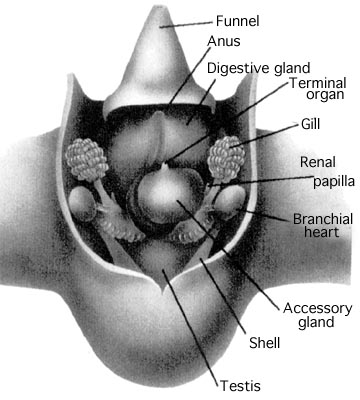
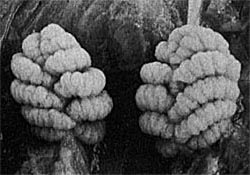

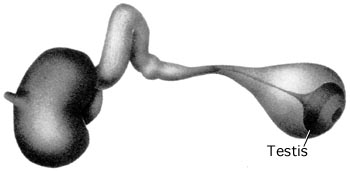

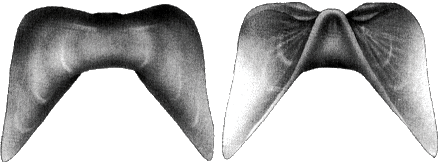
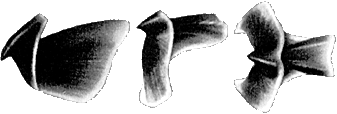




 Go to quick links
Go to quick search
Go to navigation for this section of the ToL site
Go to detailed links for the ToL site
Go to quick links
Go to quick search
Go to navigation for this section of the ToL site
Go to detailed links for the ToL site